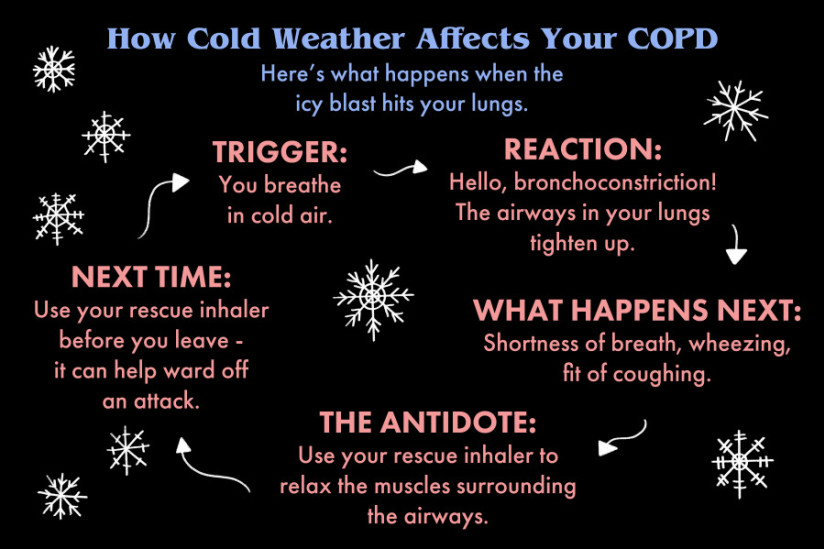What Humidity Level Is Bad for Copd
When the Weather Makes It Hard to Breathe
Small changes in temperature and humidity can make a big difference in how you feel when you have COPD. Here's what to look out for.

iStock
Ever wonder why your chronic obstructive pulmonary disease (or as you know it, COPD) seems to be worse when it's raining? Or why you wheeze more when it's windy out? When it comes to COPD and the weather, two words apply: Goldilocks Principle.
Like the three bears' porridge, the weather can be too hot, too cold, and occasionally, just right for people with COPD. "Everyone is different, but in general, if you have obstructive lung disease, it's the extremes in weather that can really present problems," says Gabriel Lockhart, M.D., a pulmonologist in the division of pulmonary, critical care, and sleep medicine at National Jewish Health Hospital in Denver.
Take a look at how common weather conditions can affect your COPD and follow our experts' advice for breathing easier, no matter what the day brings.
Forecast: High Humidity
"Humidity is one of the biggest issues for patients with COPD," says Megan Dulohery Scrodin, M.D., a pulmonology specialist and co-director of the COPD Clinic at the Mayo Clinic in Rochester, MN. "In times of high humidity, it is frequently more difficult to breathe. This increased shortness of breath can cause a COPD patient to develop more coughing or wheezing."
Exacerbating matters, high humidity can make mold and other airborne allergens worse. The ideal humidity level for people with COPD is 30% to 50%, says Dr. Lockhardt. But unless you live in regions like the American Southwest, those conditions can be hard to come by on a regular basis. And in some areas of the country, like the Pacific Northwest, days of 60% or higher humidity far outweigh low humidity ones.
Your solution for handling these conditions isn't exactly revolutionary: "In general, during times of high humidity, we recommend that COPD patients try to avoid long exposure to the outside," says Dr. Dulohery Scrodin. Also, consider running a dehumidifier indoors—especially in your bedroom at night to make sleeping a little easier.
Forecast: Heat Wave
If humidity makes breathing tough, hot weather make it even tougher. "Problems can worsen when high humidity is looped together with higher temperatures," says Dr. Lockhart. "Even people who don't have lung disease can feel like they're suffocating outside and 'swimming' through hot, humid air." If you have COPD, high heat can aggravate the condition. (There is no official temperature above which COPD symptoms can flare, but temps in the 80s and 90s will likely make your breathing worse.)
Heat is closely linked with another tormentor: High ozone. "A hot day is often a polluted day, or a high-particulate-matter day," says Greg Diette, M.D., a professor of medicine at Johns Hopkins University in Baltimore who specializes in asthma and obstructive lung disease. "Those pollutants are super-irritating to lungs, particularly if you are trying to exercise—they can cause you to hyperventilate." Aerobic exercise is especially important if you have COPD, so don't give up your workouts! Instead, try to exercise outdoors either early in the morning or later in the evening, when temps are lowest, or move your session indoors to a gym or your air-conditioned living room.
Forecast: Low Humidity
What about dry air? It seems counterintuitive that it would be a problem, but like Goldilocks' too-hot and too-cold porridge, it turns out, dry air can be as big of a stressor on your lungs as overly moist air. "This hospital was founded over a century ago with the idea that all the sunshine and low humidity here in Colorado would be beneficial, especially to tuberculosis patients," says Dr. Lockhart of National Jewish. "But some people have trouble with dry air as well. For instance, if you are a person who produces a fair amount of mucus, low humidity can actually dry out your lungs, meaning even though you have a persistent cough, you can't cough up what you need to in order to feel better."
You can find some relief by taking daily steam showers and using a humidifier in your home or workspace. Be sure to clean the humidifier weekly—bacteria can build up in the tank and you don't want the machine spewing more junk into the air you breathe.

Laura Supnik
Forecast: Freezing Temps
Cold weather? Also not your friend. As temps plummet toward the freezing mark, your odds of bronchoconstriction (tightening of the airways in your lungs) or bronchospasms go up. Cold air can also trigger shortness of breath and bouts of wheezing. "Inhaling cold air makes your airways constrict," says Dr. Diette. "That happens for anybody, but it's especially true for someone with a disease like COPD, because your airways may already be somewhat constricted and are 'twitchier' than average."
You can help your cause during winter months by dressing for the cold conditions. "If you go out, cover your mouth and nose to decrease the amount of cold air hitting your airways," says Dr. Dulohery Scrodin. A warm scarf will do the trick, or look for a neck gaiter (sold at most outdoor sports stores) that goes around the neck and can be pulled up over your mouth to warm the air as you breathe in. It may also help to use your rescue bronchodilator (short-acting meds that can provide quick relief) before going outside if you plan to be active, says Nikita Desai, M.D. a pulmonologist at the Cleveland Clinic in Ohio.
Forecast: Windy Day
If you step outside and it's a clear, mild day, don't assume you're out of the woods. A breezy forecast can blow in its own pesky problems. "Particularly in dry areas where there is dust or other particulates in the air, wind may cause an increase in respiratory symptoms, like shortness of breath, coughing, and wheezing," says Dr. Dulohery Scrodin. "Also, high winds in some areas can bring in smoke from forest fires that are not even close by, which makes respiratory symptoms worse."
Seasonal changes—particularly spring into summer—can add to symptoms as pollen soars through the air on windy days. "When seasons change, some people with COPD will experience more allergic reactions—their eyes are itchy, they have more postnasal drip—and that can cause some worsening of their cough as well as shortness of breath," says Dr. Lockhart. Face masks may help (there are a lot of cool styles available on the internet, so you don't have to look like you just escaped your hospital bed if you wear one) or wrap a scarf high over your mouth to provide some blockage between you and the elements.
Bottom line: In the perfect world, temperatures would hover at 65°F, humidity would rest around 40%, and the sky would be blue and windless every day, all year long. In reality, weather is never that cooperative and you have a busy life to live, COPD be damned. Knowing what to expect before you step out the front door can give you a head start on whatever Mother Nature has in store.
-
COPD and Weather: International Journal of Chronic Obstructive Pulmonary Disease. (2014). "The Causes and Consequences of Seasonal Variation in COPD Exacerbations." ncbi.nlm.nih.gov/pmc/articles/PMC4199860/
-
COPD and Humidity: International Journal of Biometeorology. (2017). "Synergistic Effects of Temperature and Humidity on the Symptoms of COPD Patients."
-
COPD and Cold: European Respiratory Review. (2006). "How Different Measures of Cold Weather Affect Chronic Obstructive Pulmonary Disease (COPD) Hospital Admissions in London."
-
COPD and Heat: Johns Hopkins University. (2014). "Indoor and Outdoor Heat Exposure Is Associated with Increased COPD Morbidity."
-
COPD and Pollution: International Journal of Chronic Obstructive Pulmonary Disease. (2016). "Major Air Pollutants and Risk of COPD Exacerbations: A Systematic Review and Meta-Analysis." ncbi.nlm.nih.gov/pmc/articles/PMC5161337/
-
COPD and Pollution: European Respiratory Journal. (2019). "Air Pollution, Lung Function and COPD: Results from the Population-Based UK Biobank Study."

Meet Our Writer
Alison Gwinn
Alison Gwinn is a seasoned journalist based in Denver who has written or edited on a wide range of topics—from breaking political news to health, travel, food, fashion, architecture, and interior design—for such publications as The New York Times, Entertainment Weekly, Women's Health, AARP, and O, the Oprah Magazine.
What Humidity Level Is Bad for Copd
Source: https://www.healthcentral.com/article/copd-and-weather
0 Response to "What Humidity Level Is Bad for Copd"
Post a Comment